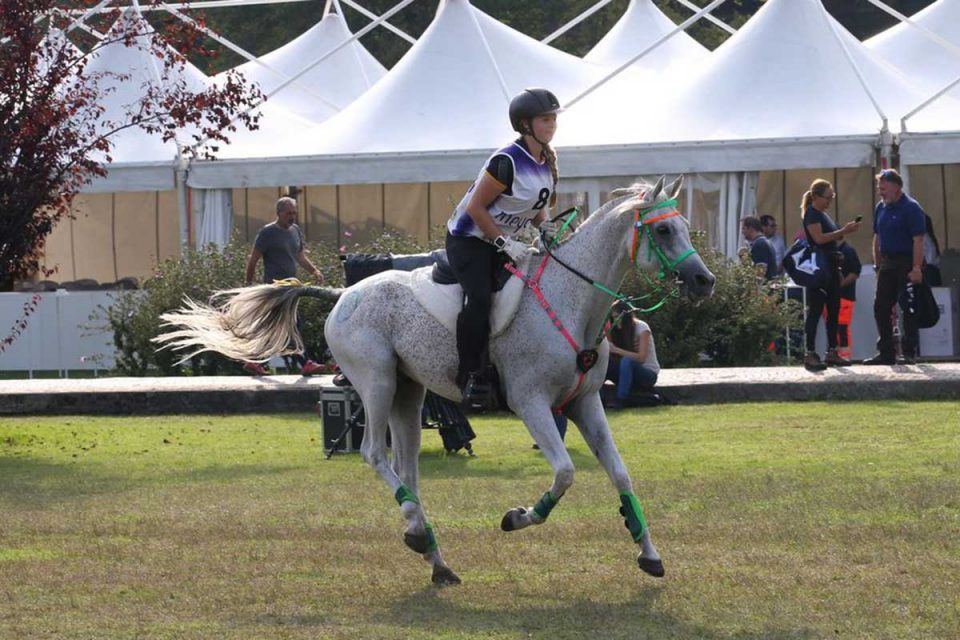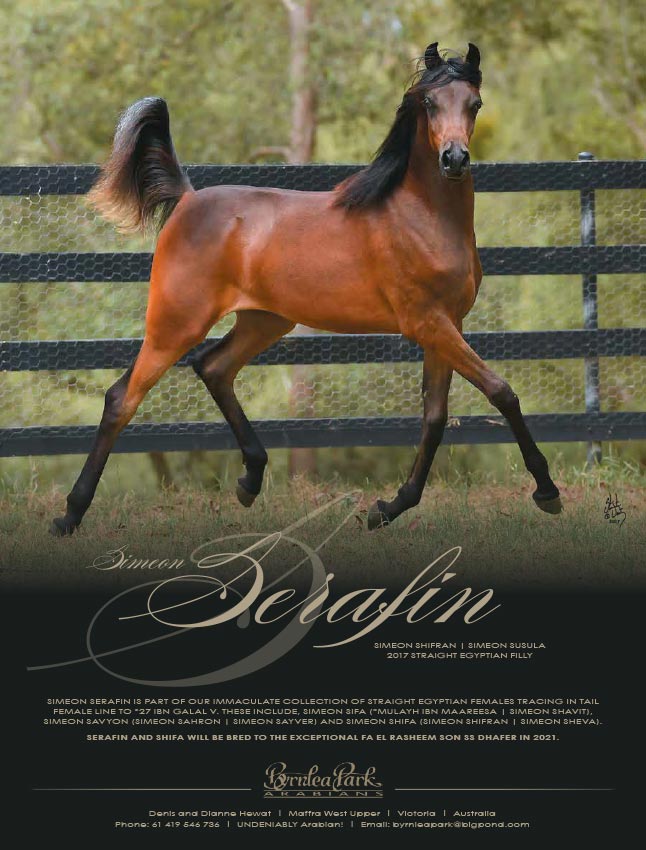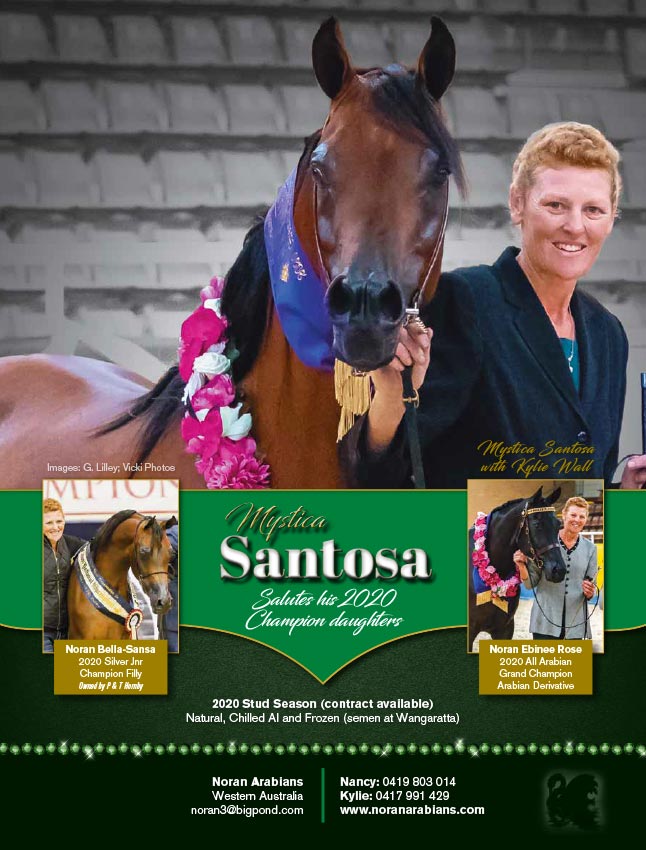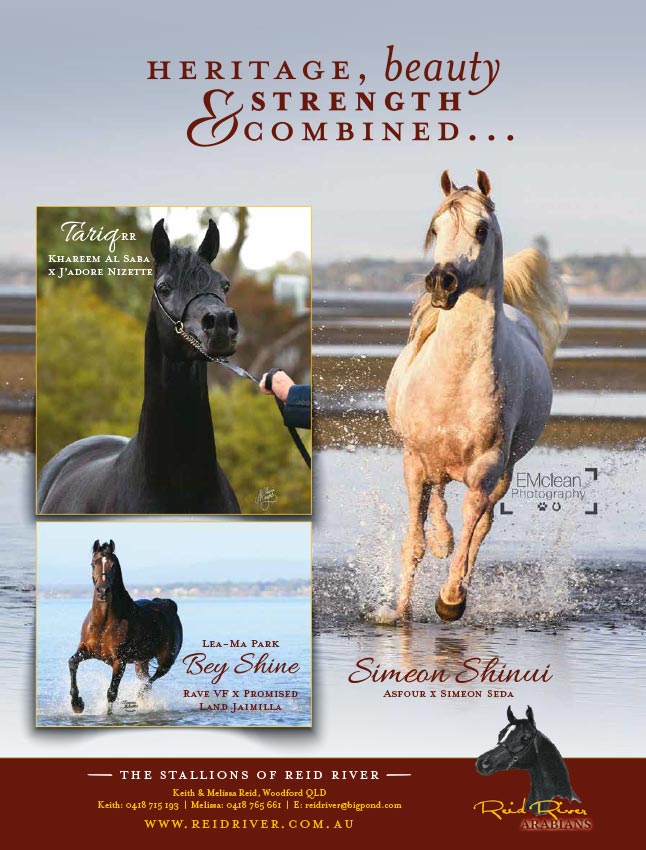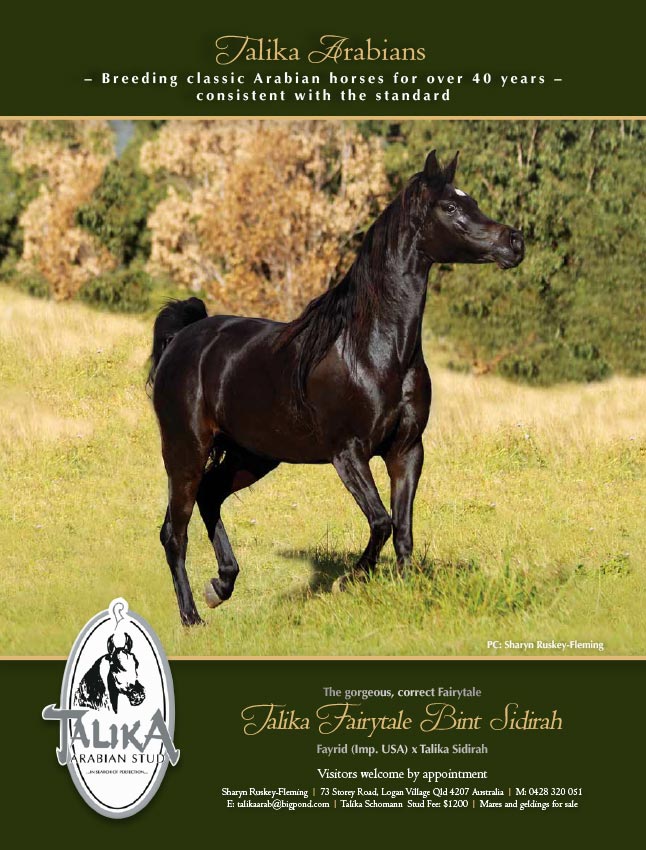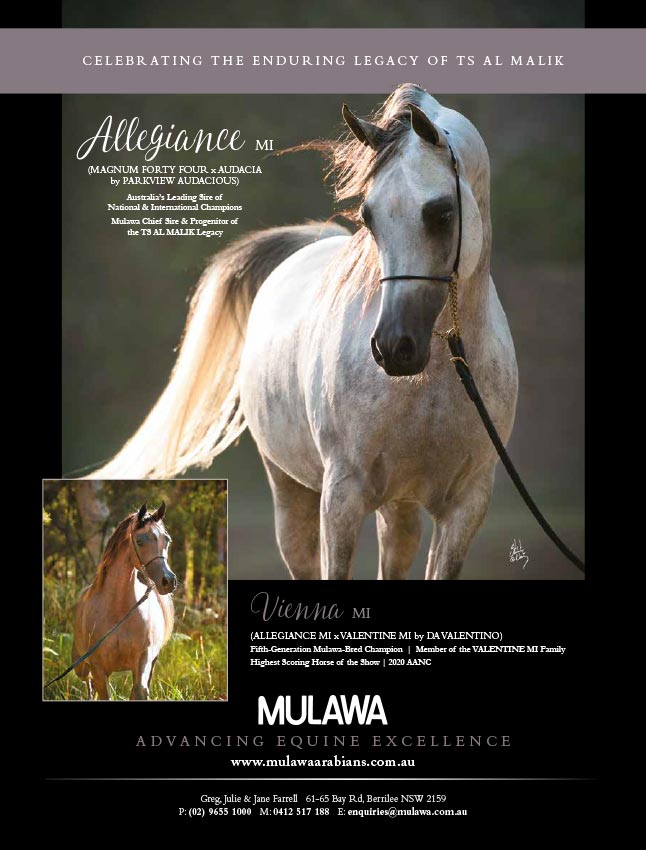Castlebar Endurance

Syriah’s Arabian Horses
August 27, 2020
Westacres
August 28, 2020Castlebar Endurance
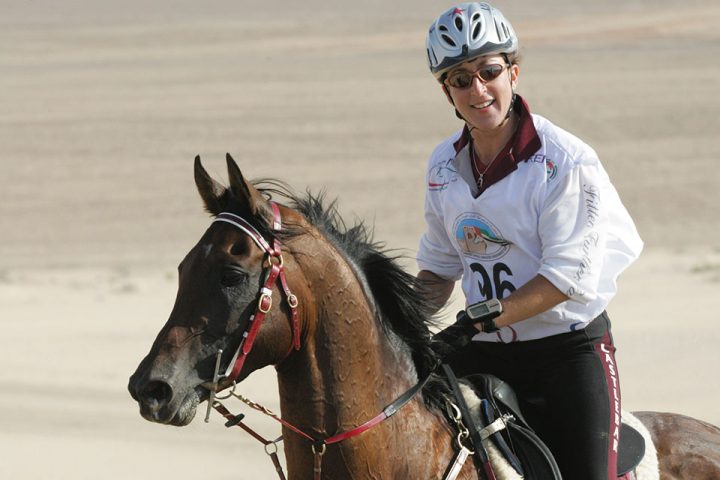
Going from Strength to Strength
INTERVIEW WITH MEG WADE
When I was a horse mad child, a very kind person named Jenny Oliver listened to my somewhat naive thoughts about becoming an endurance rider and sent me a Part Arabian gelding named Tollo to start that journey. At that time I lived in the inner suburbs of Sydney, far from rural Australia, yet we did have a few paddocks to keep horses tucked away not far from our house. A day or two after speaking with Jenny, into this suburban paradise of sorts, a lone driver with a horse float arrived with Tollo on board and even then, that naive child understood just how meaningful it was for someone to go so far out of their way to bring that horse into town. That person was Meg Wade, who would very quickly go on to become one of Australia’s most prominent endurance riders, a position she would hold for some time. It would not be a lie to say that I play that day over in my head surprisingly often, and so to have the opportunity to talk with Meg Wade again after all of these years was incredibly exciting, and ultimately both educational and inspiring.
Meg Wade and her husband Chris Gates created Castlebar Endurance, breeding, riding, conditioning and exporting some of the world’s most competitive long-distance horses. The business has gone from strength to strength, surviving both the industry flow, and a catastrophic riding accident that almost cost Meg her life.
‘A typical day at Castlebar has changed over the years because I have to do things differently now. Because of my injury, everything has had to change. I get up, have breakfast, then go up and see the staff in the yard. We have a book up in the yard that I write notes in each night…horses to be ridden, medications, breedings and so on. They tick it off as they go. We have done that for many years and it works well, as if I go up to the yards and they are out riding, I can check in the book and know what has been done. It is very efficient and leaves little room for error.
‘Most days there are two or three staff. At one stage, maybe about 15 years ago we would have had more. The situation has now changed as for many years we bred and competed with horses for Sheikh Mohammed bin Rashid Al Maktoum of Dubai, however we stopped doing that about ten years ago. So now, it is less horses in work, plus I had my accident.’

Castlebar still owns approximately 80 horses, with six or more in full time work at any time. There are usually 15 foals born each year, and they are a mixture of Purebred, Part Arabians and a few Anglo Arabians, all specifically bred for endurance.
Meg grew up on the outskirts of Sydney, in the now peri-urban suburb of Wallacia. The property was set on 500 acres, right opposite the famous Bullen’s Animal World. ‘When I was about three or four, my parents bought that property and that is where I lived all my childhood. My father had a company that manufactured products used with high voltage electrical equipment in Redfern, and my mother was a nurse before she met my father and had her family. She didn’t have a farming background per se, but she was born in Broken Hill and had clearly learned a thing or two. For example, she was the one who taught myself and my two sisters to castrate calves.’ As children Meg and her sisters all had horses. ‘I had a Shetland pony, then went to a riding pony who I did everything on. My first big horse was a palomino gelding – I did campdrafting and showing with him.’
Later, when Meg left school, one of her first boyfriends, David Hislop, was a professional cross-country skier who twice went to the Olympics. ‘My middle sister at that stage was working down in the Snowy Mountains, and I somehow managed to get down there, looking after a house that was owned by Dick Smith. I had my first ever helicopter flight with Dick Smith. I loved it! Later I got my PPLH – Private Helicopter Licence and had a helicopter at home. I worked at Paddy Pallin at Jindabyne, became a cross country ski instructor and it was at that time that I met David.
‘After meeting him, I started competition skiing as well. He was at a high level, I just competed in cross country ski races. Skiers have these “World Loppet” competitions… we have one in Australia now called the Kangaroo Loppet. The races are from approximately 80km to 110km on skis, cross country. Because he did it, I did it! I raced in Italy, Germany and throughout Europe. I didn’t win, but I finished and for some reason in my psyche, it felt natural to race long distance. We did kayaking for fitness. I did both the Hawkesbury Classic 111km and the Murray Marathon 400km 5 day races a few times.’
It wasn’t until Meg was 28, and back home in Wallacia, that she first heard about long distance horse riding. ‘There was a vet out at home, Tony Parker, who is still involved with endurance, doing some horses’ teeth. He was talking about this 100 mile horse ride he was going to. I had never heard of it so my ears pricked up as it sounded very interesting to me.’
That ‘100 mile horse ride’ was the 1987 Colo Classic, and although Meg just went out for a look, she knew this was going to be a major part of her future. ‘I loved it, I thought it was very interesting. My skier boyfriend ran the last leg with the horses!
‘I knew how to ride horses. I had gone to Cobbitty Pony Club, which was a fantastic pony club, and to jumping clinics with John Faye. I knew how to ride, and I knew about training for long distance competitions, so endurance was perfect for me. A few months later Meg rode her first 40km on a Thoroughbred mare she had at home. ‘I realised very quickly that I couldn’t use the horses I had, and that I had to buy something else. I must have bought an Arab to ride because I wanted to do endurance properly. I did my first 80km ride at the beginning of 1988. I jumped in at the deep end.’
Within a year Meg had ridden and completed her first Quilty. ‘For some reason, I decided to compete as a middleweight which meant I had to carry lead as I was a lightweight rider. Later I came second lightweight at two Quilties, then decided to again carry weight to ride as middleweight, so I could win the Quilty. You can only win the Quilty if you ride as a Middleweight or Heavyweight – 73 kilograms or over.
‘In those early days I was very fortunate to get to know Jenny Oliver very well and she mentored me. I still catch up with her a couple of times a year. I also got to know Kevin Bohm from Kelkette Park. Those early connections are very important for new endurance enthusiasts.’
When asked what makes a good endurance horse, Meg is adamant that the combination of breeding and conformation are equally important. ‘Genetics come into it a lot. You have to have the basic good conformation. Feet are everything, you must have good feet, I don’t care what colour they are, and height doesn’t really matter. We shoe our horses, but you have to have a good farrier. A farrier can ruin things in one fell swoop.


‘I was very fortunate the manager that Mum had at the farm in Wallacia at that time – John Really, also worked for Claire Proudford. It was through him I bought two stallions that she bred who were related to Aethon, who I always like to see in any horse’s pedigree. Those stallions were Tribal and Seraja. I competed on both of them, and their names still crop up in the pedigrees of the horses I have today.
‘A good, quick heart rate recovery is definitely linked to genetics. I also love the Chip Chase Sadaqa line. His daughter Crystal Flyer (from Franklin Rajull) was a great mare – I won my first Quilty in 2000 on her.
Her full sister Kurrajong Concorde won the 2011 Tom Quilty in South Australia with Kristie Taprell, and was then sold and exported to the UAE and went on to win the 2014 World Championships ridden by Sheikh Hamdan bin Mohammed Al Maktoum.
‘Another great broodmare for us was Shir’amar Obsession (Simeon Sa’ar x Dynasty Tamir by Crème Dynasty). She is completely different lines to what I am used to, and is the dam of one of Sheikh Abdulla’s best endurance mares, Castlebar Odessa. She races under the name of Castlebar Sobia in Europe and the Middle East, as she is a case of mistaken identity.
‘Shir’amar Obsession is also dam of our stallion Castlebar Odyssey. He only raced a couple of times, but for some reason he was such a loud mouth at rides and it was annoying for me and for everyone else. We never had a stallion like that before. We have competed with many, but Odyssey just roared and carried on at rides. At home he is an amazing horse to handle. We paddock serve with him and he is fantastic… take him to a competition and he would be terrible. So, we breed great foals with him now, and this season we are collecting semen (frozen) for export to Europe.’
During 2018 Castlebar imported a colt from France named Mounir Font Noire (Lakshmi Font Noire x Medjana). He is of predominantly Russian and Polish bloodlines, the best of performance lines available in Europe today. Meg is extremely excited about the future of this colt. ‘He was three in March this year, and we will start breeding with him this season. He has the most beautiful bloodlines you can imagine and will cross very well with our mares.’
At Castlebar, mares are foaled down naturally in paddocks and the climate and soil is such that they are raised almost exclusively on pasture, with little hard feed unless in work. ‘We use foaling alarms which are fantastic. When they get close, you will have the odd false alarm but all in all, it’s worth it and I wouldn’t do it without them. As the foals grow we bring them in regularly and do bits of handling with them when they are on their mothers. Once they are old enough to drench, we have a crush and we walk the mother in there and the foal comes in with the mother. Then you can drench the foal. We don’t put halters on them as babies.
‘We break them in at around five years old, they are nicely grown and then can be kept in work and can do more in a competition sense.
‘My first really competitive endurance horse was Glenallen Sheida, who I competed on at the first WEG I went to in 1994 at The Hague. She also carried me to 2nd Lightweight at two Quilties. Aloha Gossip was another who I did very well with, including at the European Championships. Kurrajong Sequel was another stand out.
When asked about favourite horses over the years, Meg is very quick to single out the legendary mare China Doll, on whom Meg won the 2008 Tom Quilty. ‘She is still here and is a broodmare, her foals are doing well. One of the colts that I have kept is out of her. He is by a stallion of ours called Aloha Delta. It’s funny because this is ‘just a partbred’ – I always used to say you don’t keep partbred colts, however because it’s such beautiful breeding and he has got the looks, I kept him. At the end of the day I am a bit like that now, if they are a good horse they are a good horse.
‘I also loved riding a mare named Castlebar Kalahari. She was by Castlebar Khalifa who I also liked riding a lot. Actually, he was an alltime favourite…maybe more than his daughter or China Doll.’
On 12 April 2009 Meg suffered a lifechanging accident at the Tumburumba FEI competition 110km race. ‘I don’t remember any of it. On the last leg, I only had about 10km to get to the finish, I had just passed through a checkpoint. They had recorded my number going past, nobody saw anything happen, but they saw a horse with no rider, and then saw me on the ground. One of the guys at that checkpoint who had a background in military realised something was very wrong and alerted the ride base. I was lucky it happened there, it could have happened miles from anywhere and I would not have been found for a long time. Fortunately, Trish Annetts was on the Ground Jury, she is a human doctor. Along with the ambulance staff, she determined my oxygen uptake was down so she put in what is called a Guedel tube, and I was then helicoptered out. I was three on the Glasgow Coma Scale …the lowest point on the scale you can be (the Glasgow Coma Scale ranges from 3 to 14).’
Once in Canberra Hospital Meg was put in an induced coma. ‘When you come out of a coma, you don’t just wake up and start talking. Not like on the movies. When you come out you go into PTA, Post Traumatic Amnesia. It varies from hours to days, and if you are in PTA for a week then they say it’s severe. I was in PTA for three and a half months. I was in Canberra Hospital for six weeks when they realised I was going to survive, and they wanted to move me so I could begin rehabilitation.’ Meg’s voice begins to crack, and tears appear on her face as she tells the next part of the story. ‘That was when Sheikh Mohammed bin Rashid Al Maktoum Ruler of Dubai, stepped in. The hospital was planning to move me to Sydney. It was complicated because at that time I lived in Victoria, my accident was in NSW and I was in an ACT hospital. My family found out that one of the best places for people with Acquired Brain Injuries was Epworth Hospital in Melbourne. Sheikh Mohammed somehow found out and got me into Epworth. The story goes on from there.’
Meg is now able to ride again, however not in the same way she used to. ‘Since my accident I have done a couple of 20km rides. Right now, I am not riding at all. What was damaged mostly for me is my balance. I can walk but I need a stick, and even with the stick I still fall over sometimes. I can’t get on the horse properly, and when I am on I can only walk.
‘I am very fortunate I have my driving licence back. I am sure people get absolutely terrified when they see me get out of a huge Landcruiser and notice I can hardly walk! Bull bars are very handy to hold onto when you are walking around the front of the car.’
When asked what is next, Meg’s eyes light up! ‘The most exciting thing for me right now is the new French stallion. Mounir means “the most perfect man in the world, shining and glorious”…it’s a great name. For many years I had been wanting to incorporate the best of French endurance bloodlines with Australia, and this year we are going to do it.’




